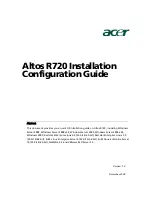
Cisco C880 M5 Configuration Guide
12
2.1 Technical Background
IPMI and “in-band” and “out-of-band” management
In the field of system management, a distinction is made between “in-band” and “out-
of- band” management:
l
The term “in-band” management is used when the operating system is running
on the managed server.
l
The term “out-of-band” management is used when the operating system is not
running on the managed server, for instance if the hardware is faulty.
As different interfaces are available in an environment with IPMI compatible systems,
you can manage IPMI compatible systems either “in-band” or “out-of-band”.
Channel concept under IPMI
‘Channels’ provide the mechanisms with which IPMI messages are routed to the
BMC via various connection carriers. Up to nine channels can be supported. The
system interface and the primary IPMB are fixed. The other seven channels are
available for the implementation.
Channels can be either ‘session based’ or ‘sessionless’. The ‘session’ concept has
two meanings: It is either a concept for user authentication or a concept for routing
multiple IPMI message streams via a single channel.
Examples of ‘session based’ channels are LAN channels or serial/modem
channels. Examples of ‘sessionless’ channels are the system interface and the
IPMB.
User identifications
For ‘session based’ channels, a user login is necessary. By contrast, the
‘sessionless’ channels have no user authentication.
Under IPMI, the user configuration is channel specific. Thus, users can have different
privileges depending on whether they are accessing the BMC via the LAN channel or
the serial channel.
Fencing
In high available clusters problems can arise if the node considered failed is not
actually failed. If, for any reason, it is not really down and it is still connected to the
storage solution, node still tries to communicate and write data.
With two nodes connected to the same storage running, the storage can be easily
corrupted, leaving the nodes in an inconsistent state. This is where fencing comes in.
With fencing, even when the cluster doesn’t know what is happening on some node,
you can make sure that node doesn’t run any or certain important resources.
So fencing refers to the idea of isolating nodes considered down and preventing them
from writing anything to the shared storage. The fencing feature on the iRMC can
request a shutdown of a remote device, if IPMI fencing is enabled. See the "C880 M5
User Interface" manual for how to enable IPMI fencing.
References
Information about the IPMI standards can be found on the Internet.











































